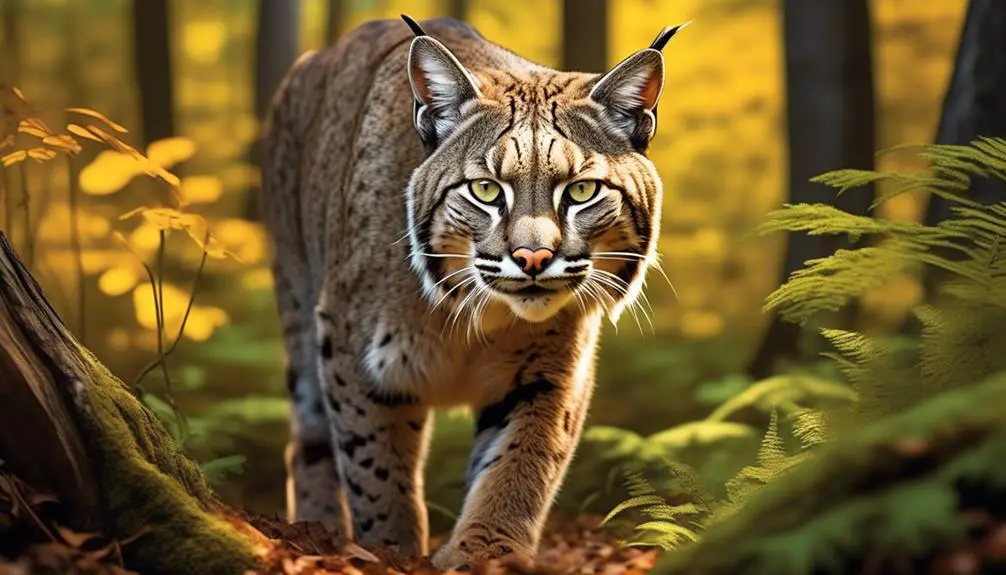Have you ever wondered what it would be like to come face to face with a wild cat in the untamed wilderness of Massachusetts? Well, prepare to be intrigued as we delve into the captivating world of these elusive creatures.
From the stealthy bobcats that roam the forests to the majestic mountain lions that once graced this land, the wild cats of Massachusetts have a story that will leave you wanting to know more.
So, get ready to embark on a journey through the rugged landscapes and uncover the secrets of these awe-inspiring feline predators.
Bobcats in Massachusetts
Bobcats are a species of North American wild cats that can be found in various regions of Massachusetts. Descendants of the Eurasian lynx, bobcats reside exclusively in North America, with their range extending from southern Canada to central Mexico. In Massachusetts, bobcat population densities are highest in western regions. They can also be found in all New England states, including Massachusetts.
Bobcats prefer habitats such as mountainous areas, hardwood forests, swamps, bogs, and brushy areas. However, they’re less frequently found in agricultural and suburban areas. They thrive in wooded areas near clear cuts. Due to their nocturnal nature, bobcat sightings are rare.
Adult bobcats are slightly smaller than Canadian lynx and have bobbed, short tails with black tips. Their fur is usually gray to brown with mottled dark spots. Bobcats have black stripes on their inner forelegs and tail, as well as black-tufted ears with a white spot in the center.
Bobcats are aggressive predators and mainly feed on small mammals like rabbits, squirrels, and mice. They also consume reptiles, birds, insects, and carrion. On occasion, they may prey on larger animals such as deer. In residential areas, they may target small livestock or pets. While young bobcats may occasionally fall victim to coyotes, domestic dogs, great horned owls, fisher cats, and foxes, they’ve no significant predators in Massachusetts.
Bobcats mate in February and March, with males mating with multiple females. The gestation period for bobcats is 60 days, and females are responsible for selecting den sites and raising the young. Bobcat kittens are born with sealed eyes, which open after a week to 10 days.
Canada Lynx in Massachusetts
The diverse population of wild cats in Massachusetts extends beyond bobcats, with another notable species being the Canada Lynx. However, it’s important to note that Canada Lynx are completely extirpated from Massachusetts, along with Rhode Island and Connecticut.
The Canada Lynx is primarily found in the boreal forest in Canada and the northern United States, with populations in Alaska, Maine, New Hampshire, Vermont, Minnesota, Montana, Idaho, and Washington. There are also populations in Colorado, northeastern Utah, and northern New Mexico. Listed as a threatened species under the Endangered Species Act, the Canada Lynx is protected under federal law, and efforts are being made for its conservation and management.
The Canada Lynx closely resembles the bobcat but is slightly larger with longer legs. They’ve long, thick grey fur in winter and a thinner, shorter reddish-brown coat in summer. Notably, unlike bobcats, Canada Lynx don’t have black bands on the topside of their tails. With their large, furry feet that function like snowshoes, Canada Lynx are able to travel and hunt on top of the snow.
Although they aren’t currently found in Massachusetts, understanding their distribution and conservation status is essential for the overall understanding of the wild cat population in the region.
Mountain Lions in Massachusetts
Mountain lions, also known as pumas or cougars, were once prevalent in Massachusetts before European colonization. However, the last known mountain lion in Massachusetts was killed around 1858.
The decline of mountain lions in the region can be attributed to several factors. One significant factor is the loss of their primary prey, the eastern cougar, which was driven to the brink of extinction. Today, the only known population of mountain lions in the eastern United States resides in Florida, known as Florida panthers.
Sightings of mountain lions in Massachusetts are often cases of mistaken identity, involving large bobcats, coyotes, or domestic dogs. It’s important to note that there’s currently no established population of mountain lions in Massachusetts.
While mountain lions have been known to disperse and travel long distances, it’s unlikely that they’ve reestablished a breeding population in the state. Therefore, any reports of mountain lion sightings should be carefully evaluated and verified.
Habitat and Range of Wild Cats
Wild cats in Massachusetts are known to inhabit a variety of ecosystems, including mountainous areas, hardwood forests, swamps, bogs, and brushy areas. These habitats provide the necessary resources for wild cats to thrive and survive. Mountainous areas offer ideal terrain for hunting and shelter, while hardwood forests provide ample cover and prey. Swamps and bogs are important for their water source and support a diverse range of prey species. Additionally, brushy areas offer dense vegetation for camouflage and hunting opportunities.
In Massachusetts, the bobcat is the most common wild cat species. They’re well-adapted to the state’s diverse habitats and can be found throughout all New England states. However, their population densities are highest in western Massachusetts. Bobcats are less frequently found in agricultural and suburban areas, but they thrive in wooded areas near clear cuts.
Bobcats are aggressive predators and their diet mainly consists of small mammals like rabbits, squirrels, and mice. They also feed on reptiles, birds, insects, and carrion. Occasionally, they may prey on larger animals like deer, especially in residential areas where small livestock or pets may be targeted. Coyotes, domestic dogs, great horned owls, fisher cats, and foxes may occasionally kill young bobcats, but they’ve no significant predators in Massachusetts.
Conservation Efforts for Wild Cats
Conservation efforts for wild cats in Massachusetts are focused on protecting and preserving their habitats, managing human-wildlife conflicts, and promoting public awareness and education.
The preservation of suitable habitats is crucial for the survival of wild cat populations. This involves maintaining and restoring the diverse ecosystems that support their prey species, such as rabbits, squirrels, and mice. Protecting these habitats not only ensures a stable food supply for wild cats but also helps maintain the overall biodiversity of the region.
Managing human-wildlife conflicts is another important aspect of wild cat conservation. This includes implementing strategies to minimize the negative interactions between humans and wild cats, such as providing guidance on securing trash cans and pet food to prevent attracting wild cats to residential areas. It also involves implementing measures to reduce conflicts with farmers, such as the use of deterrents and fencing to protect livestock from predation.
Promoting public awareness and education is essential for fostering a positive attitude towards wild cats and their conservation. This can be achieved through campaigns, educational programs, and outreach activities that highlight the importance of wild cats in maintaining healthy ecosystems. Public participation in citizen science initiatives, such as reporting wild cat sightings or monitoring their populations, can also contribute to conservation efforts.
Conclusion
In conclusion, the wild cats of Massachusetts, including bobcats and Canada lynx, have adapted to thrive in the diverse landscapes of the state.
While mountain lions no longer inhabit Massachusetts, efforts are being made to preserve and protect these majestic creatures in their natural habitats.
Understanding their habitat preferences and hunting behaviors is crucial for successful conservation efforts.
By studying and appreciating these wild cats, we can ensure their survival and maintain the balance of nature in Massachusetts.

Erzsebet Frey (Eli Frey) is an ecologist and online entrepreneur with a Master of Science in Ecology from the University of Belgrade. Originally from Serbia, she has lived in Sri Lanka since 2017. Eli has worked internationally in countries like Oman, Brazil, Germany, and Sri Lanka. In 2018, she expanded into SEO and blogging, completing courses from UC Davis and Edinburgh. Eli has founded multiple websites focused on biology, ecology, environmental science, sustainable and simple living, and outdoor activities. She enjoys creating nature and simple living videos on YouTube and participates in speleology, diving, and hiking.

